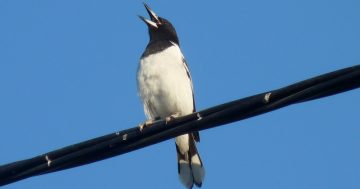
This young koala already has large and powerful claws for climbing hard eucalypt trunks and branches. Photo: Ian Fraser.
The recent report of a koala in woodland in the far north of the ACT, on land proposed for future suburban development, was both surprising and exciting.
Koalas were quite common in the local area until about 1901; Queanbeyan newspapers reported hundreds of them, though this was mostly in the context of tallies of skins for sale. The crash of these populations after that was doubtless at least in part due to this hunting pressure (though it was minor here relative to the slaughter of hundreds of thousands of koalas that took place nearer to the coast, from South Australia to Queensland).
Koala numbers have never recovered from the post-World War I skin trade and are now falling again due to the ongoing loss of forests.
We know that they still survive locally, in the Tallaganda Range and near Bredbo to the south of Canberra, and on the Kowen Escarpment to the north-east, but there are hardly any recent records from the ACT itself (the population at Tidbinbilla came from Victoria).
The initial official responses to the latest sighting are encouraging, but we shall see.
In the meantime, this is an excellent reason for a column on this most remarkable ancient Australian (which is absolutely not a ‘bear’!)
Koalas are literally one of a kind; their closest relatives are wombats, but that connection was tens of millions of years ago. Perhaps the most obvious thing about them is also one of the most astonishing – their almost total reliance on eucalypt leaves. Only one other mammal (the Greater Glider) has managed this.

Koalas aren’t ‘lazy’ – they’re active at night and need to sleep for up to 19 hours a day to allow for the high energy needs of their complex digestive system. Photo: Ian Fraser.
The thing is that these leaves must be among the worst foods in the world – they are low in nutrients, hard to digest and are full of very nasty toxins. However, on the plus side, there is an almost infinite supply of them if you can eat them.
As you can imagine, koalas have some pretty amazing adaptations that enable them to do this. Their caecum (part of the large intestine) is the largest in the world, two metres long and 10 centimetres in diameter, full of special bacteria to break down the cellulose in the leaves by fermentation – this can take up to eight days.
Young koalas are weaned on ‘soup’ from their mother to inoculate them with the bacteria. In addition, they have a very large liver to help them break down the toxins in the leaves.

Koalas have a flat forward-facing face like ours, which I think is why they’re seen as ‘cute’. Photo: Ian Fraser.
All this specialised digestion is very energy-consuming, so koalas sleep up to 19 hours a day to conserve energy for the process. Contrary to popular belief, they are not ‘lazy’ (or ‘drunk’!), just well-adapted to a most unlikely diet. They are actually very quick and agile when the situation requires it – I’ve seen a koala gallop along a branch and leap across a considerable gap to another tree.
To change trees, they otherwise have to come down to the ground where they are at their most vulnerable so they can run swiftly to get back into another tree, where they have almost no predators.
A male koala defends a territory of up to two hectares, which will include two or three females, but he only establishes himself after some five years of wandering alone until he is big enough and experienced enough to fight off rivals. The snarling roar of a male koala proclaiming his territory at night can be a terrifying sound to someone who isn’t familiar with it.

Koalas’ powerful sharp claws leave distinctive cuts in the bark of the trees they’ve climbed. Photo: Ian Fraser.
By about six months, the joey is furred and has left the pouch, and after another six weeks, weighs about 500 grams and is riding underneath its mother. By 36 weeks it weighs a kilogram and is riding on her back and starting to nibble leaves, but still sleeps and shelters from the rain under her.
At a year old, it is becoming very adventurous, and the mother mates again.
Young females stay close by and breed when they are two years old, producing a young per year for the next 12 to 15 years. As we’ve seen, the young males must leave home and roam.
Today, the greatest threats to koalas are continued habitat loss and Chlamydial disease, which is caused by a bacterium related to the ones that cause trachoma and pelvic inflammatory disease in humans. It’s not clear why it has become a major problem, but perhaps it’s related to overcrowding in isolated koala refuge areas.
We must hope that the one that has appeared in the north of the ACT avoids these hazards and can be part of a growing population in due course. It will need help, though.
Ian Fraser is a Canberra naturalist, conservationist and author. He has written on all aspects of natural history, advised the ACT Government on biodiversity and published multiple guides to the region’s flora and fauna.





















